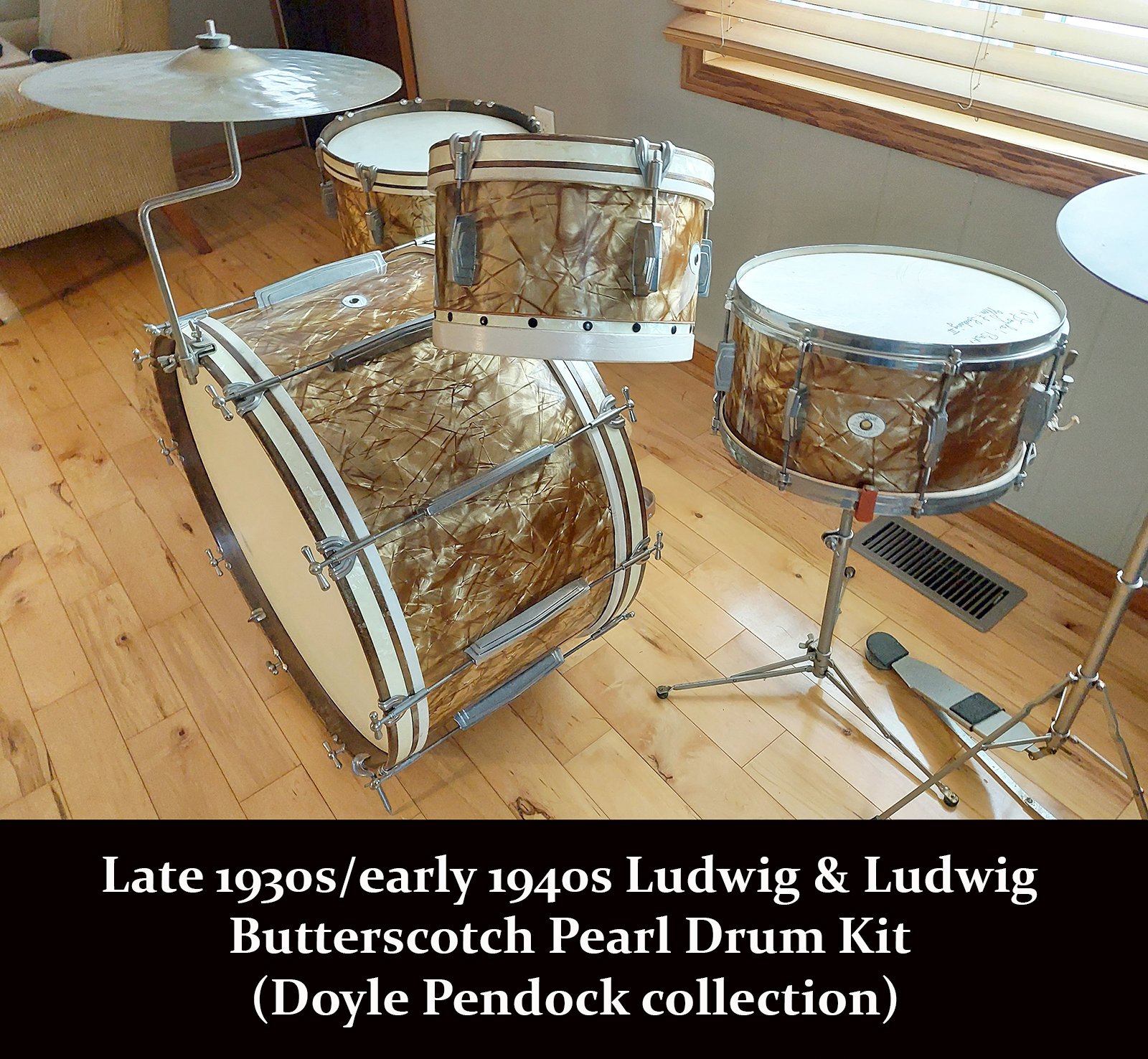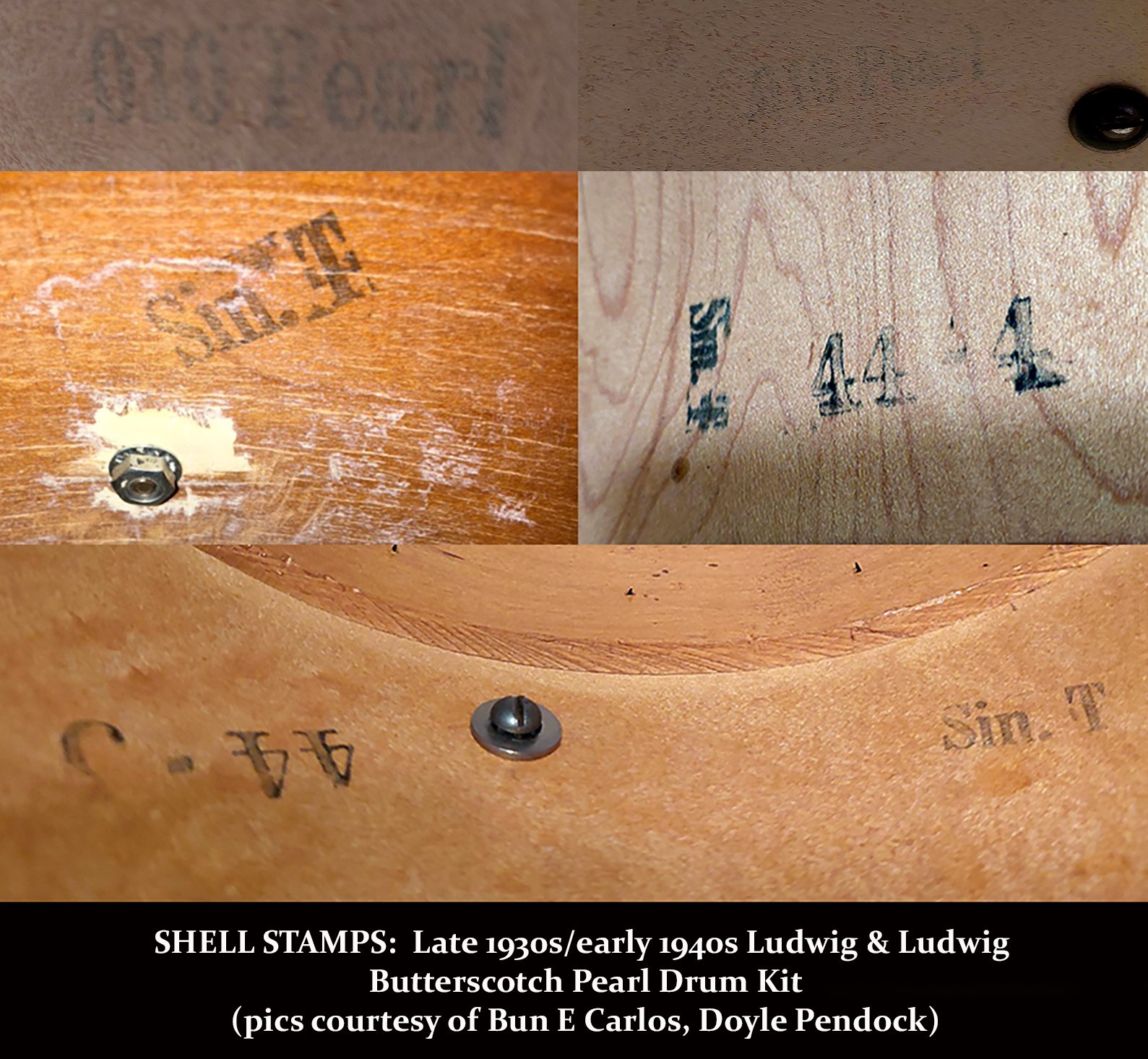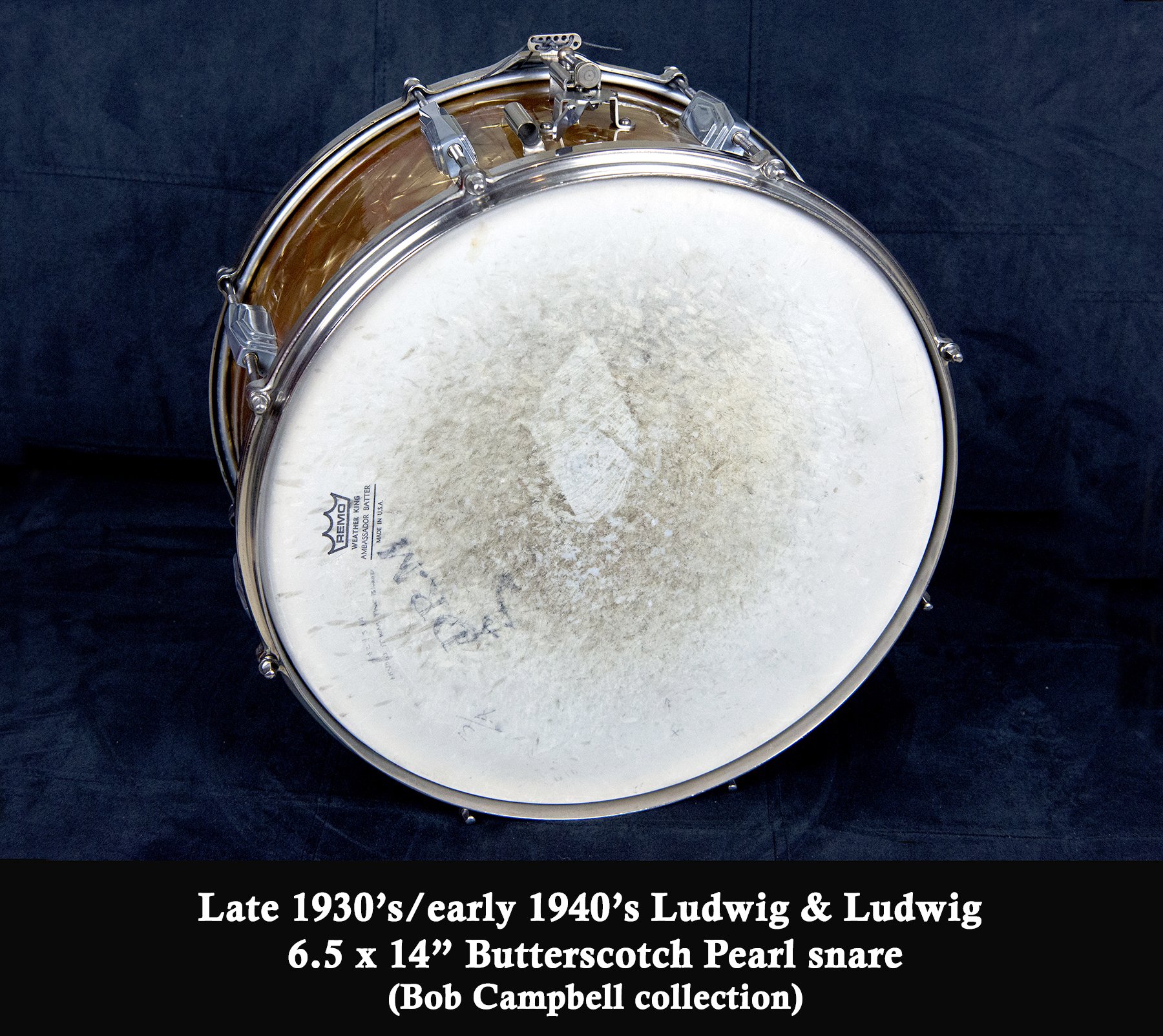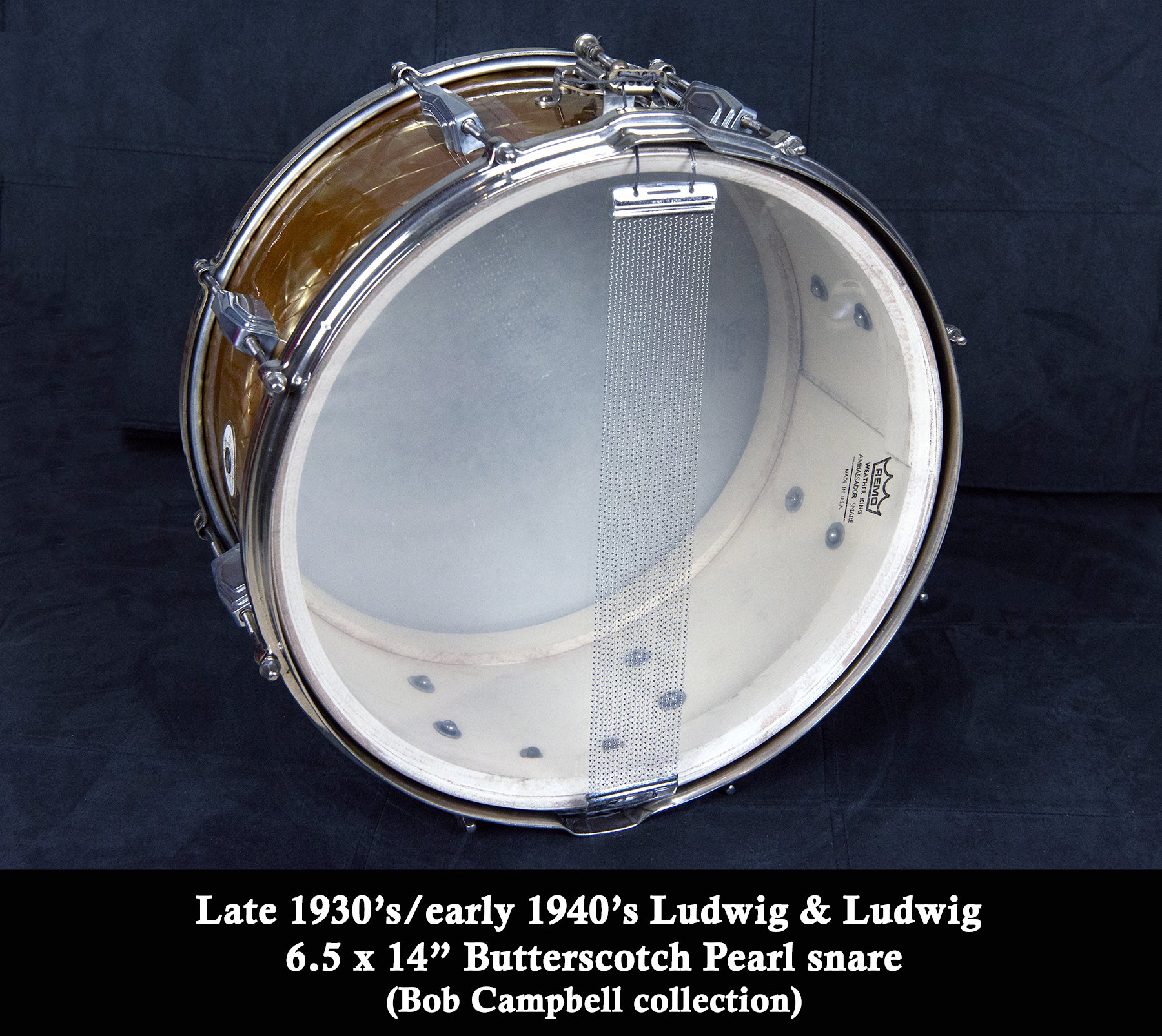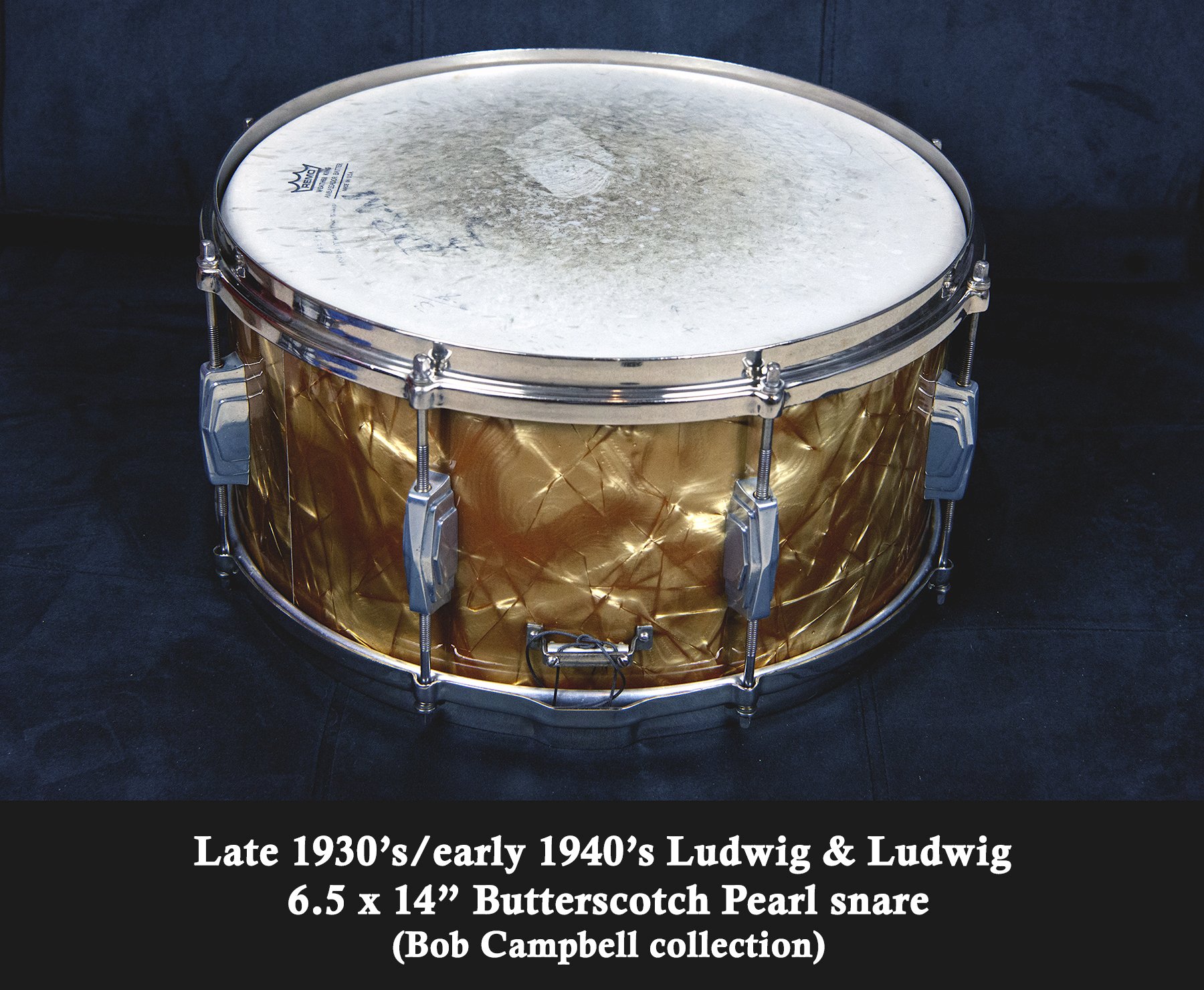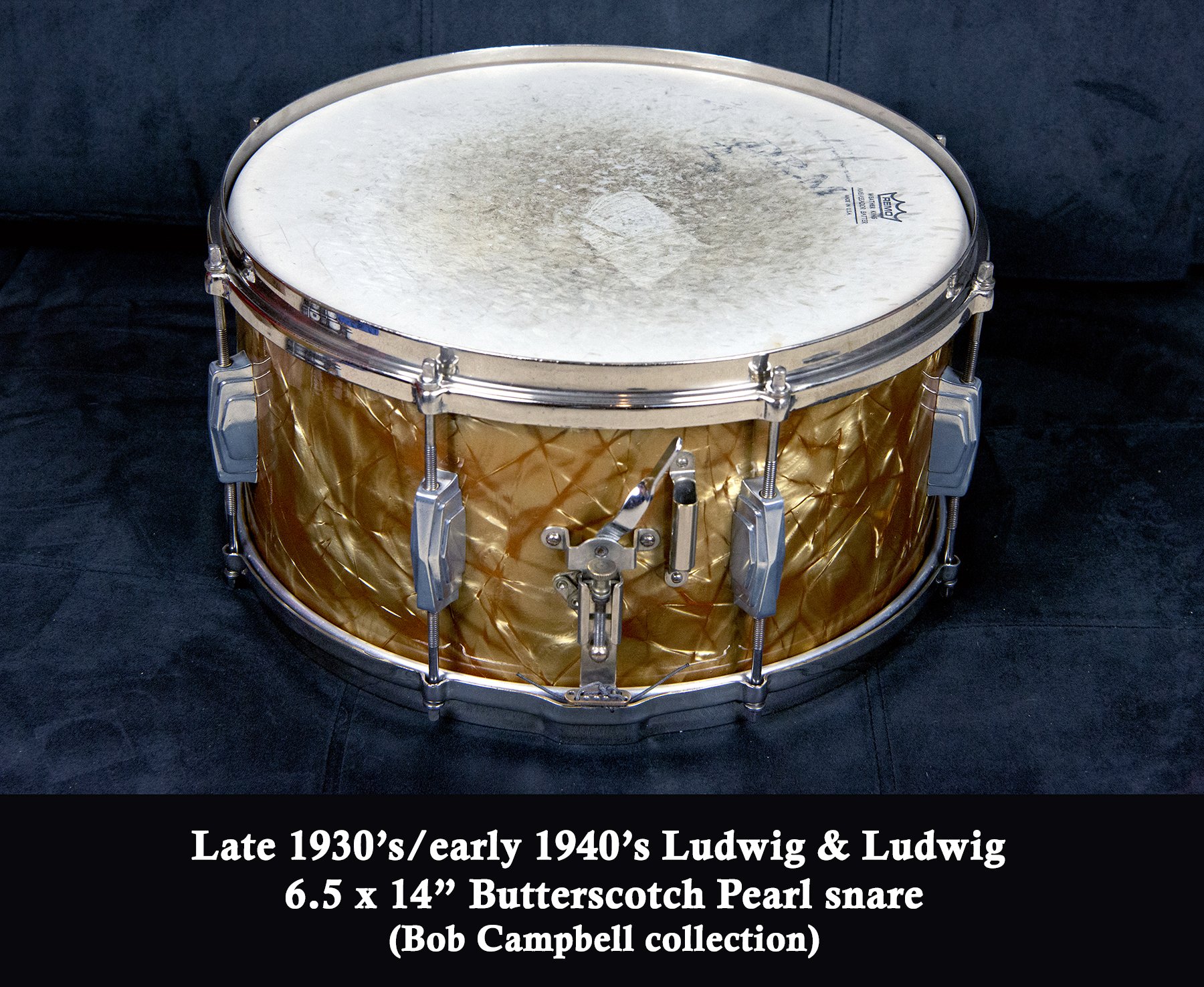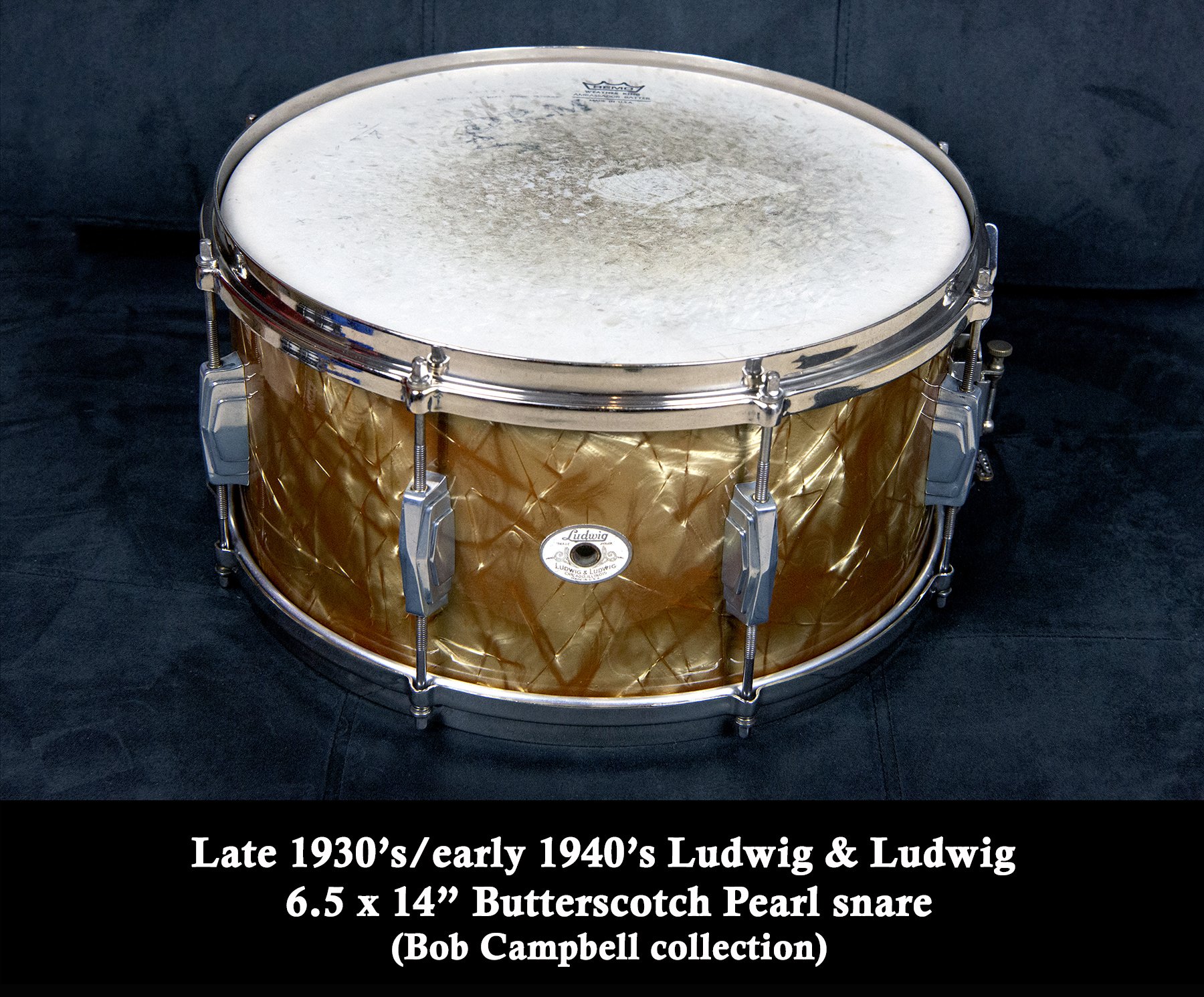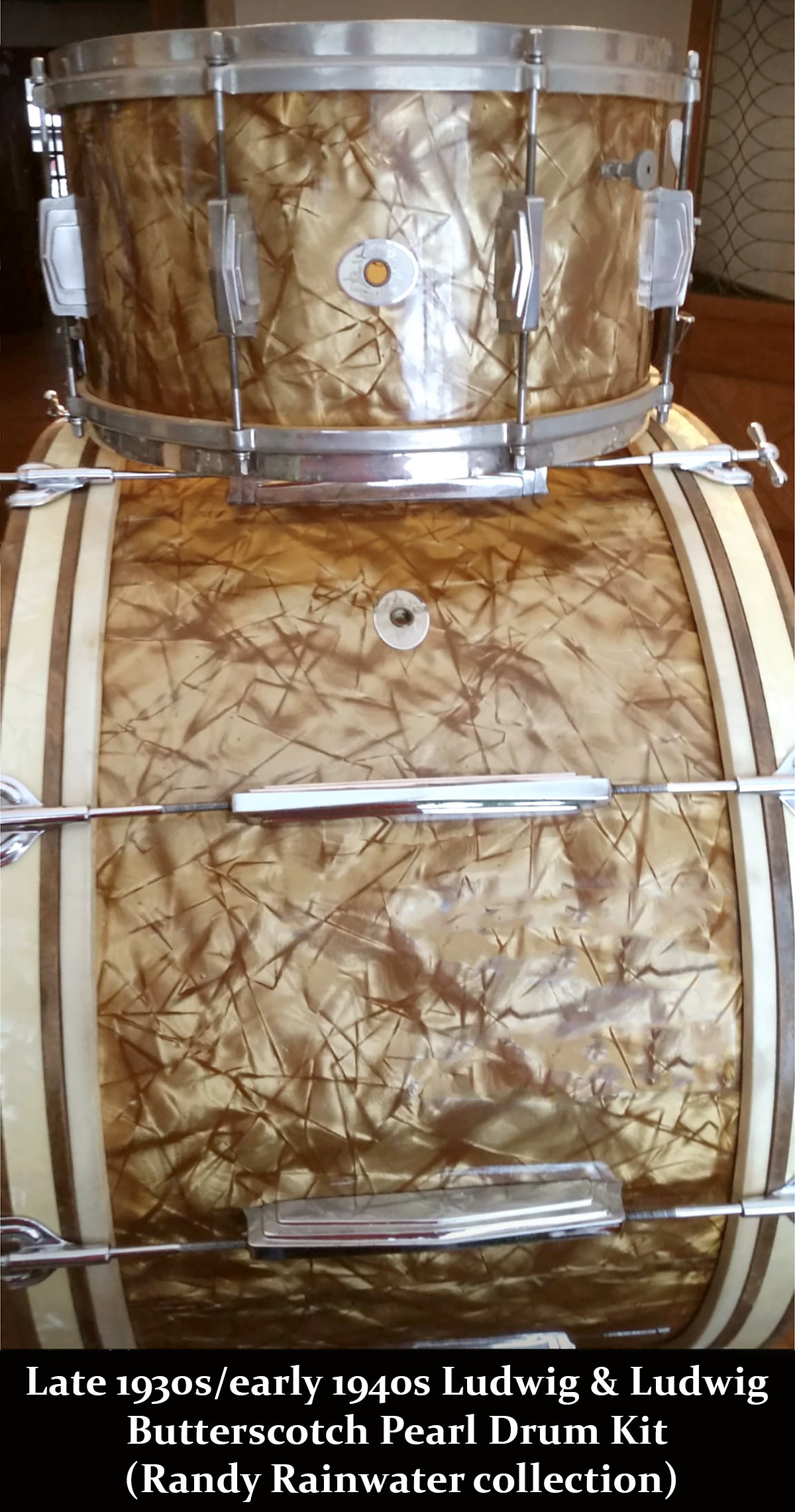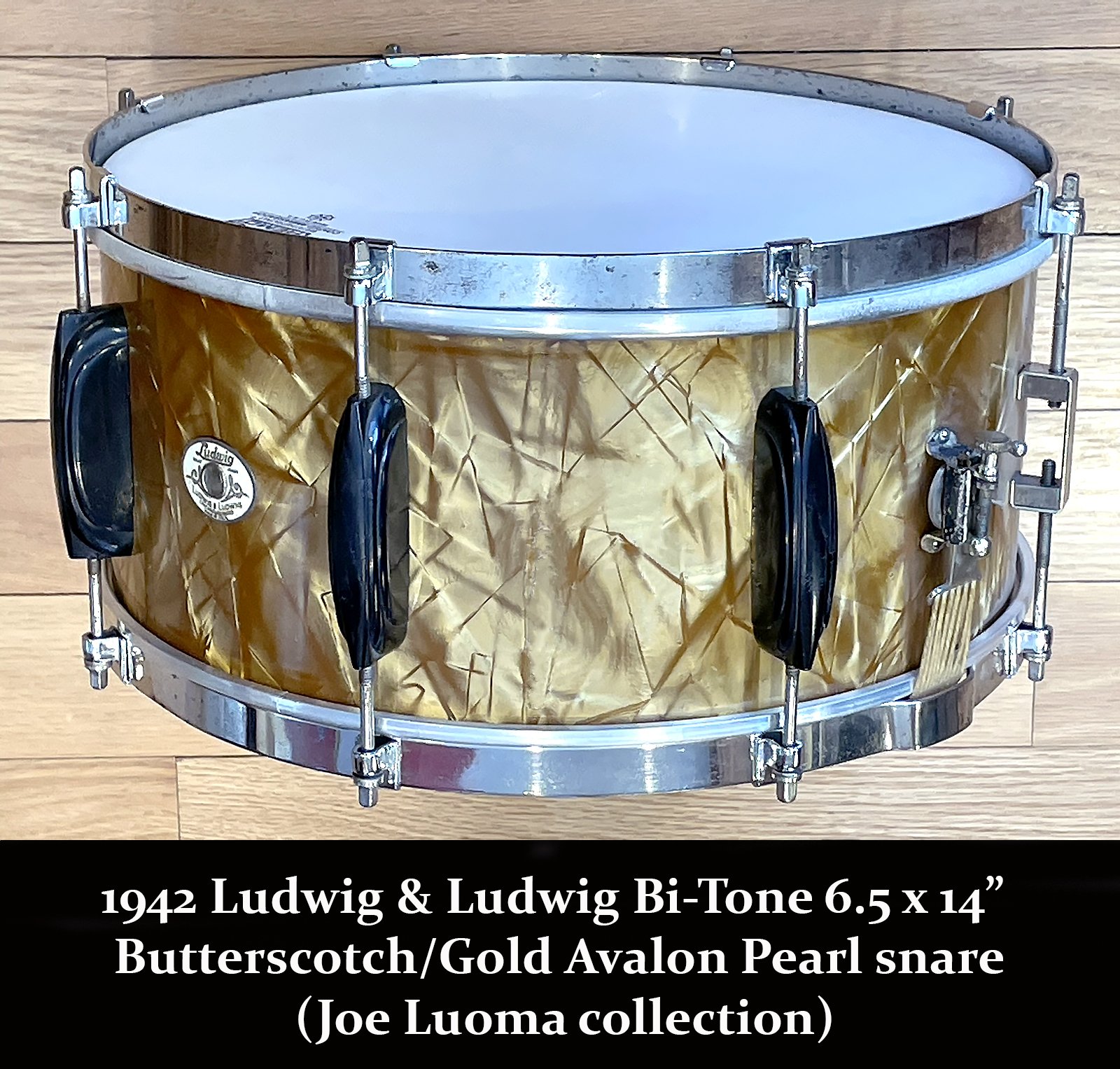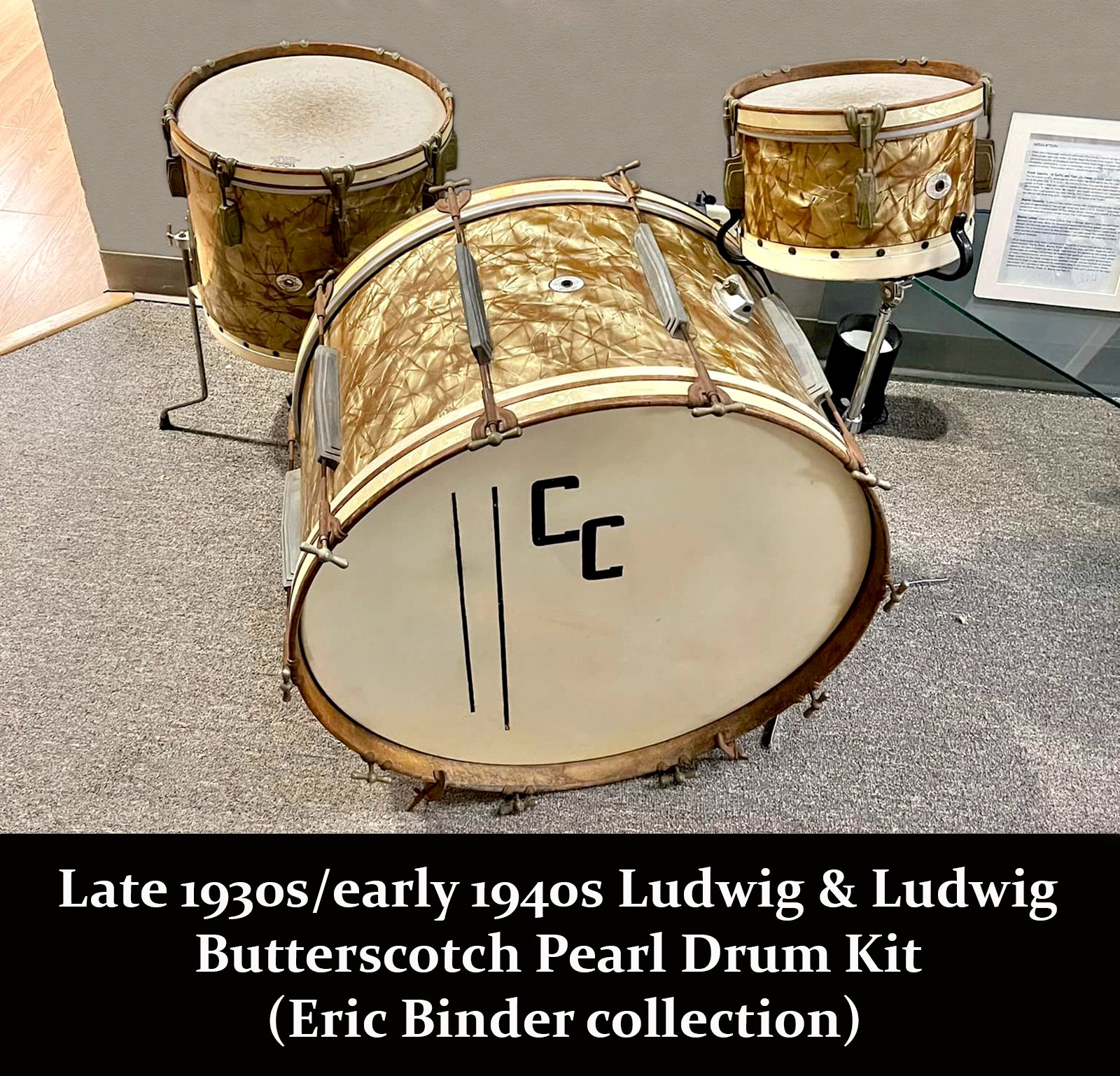The Mystery of Ludwig & Ludwig “Butterscotch Pearl”
There have been sightings over the years of Ludwig & Ludwig oval-badged drums with an unusual dark golden marine pearl wrap. The history of these drums is a bit unclear as Ludwig catalogs, ads, or brochures do not reference them. I first saw such a kit in Bun E Carlos’s collection back in a visit to Rockford, IL in 2013. I was quite struck by the amazing, rich, golden color of the pearl. Bun E assured me that this wrap was not a faded black or white Avalon pearl, nor a re-wrap, but a unique and rare pearl often referred to as "Butterscotch Pearl”. As this wrap is uncatalogued, the real name has been lost to history. Howvere, HoweverHowever, Butterscotch Pearl did indeed describe the wrap well. Bun E’s Butterscotch Pearl kit had a 6.5 X 14” snare, 14 x 26” bass drum, and 7 x 11” and 12 x 15” toms; the toms having wood hoops on top and tacked/single tension bottom heads.
For almost a decade, it has been my mission, perhaps better described as an obsession, to learn more about these drums, perhaps even own one. I have since tracked down what I believe are all the known owners of these drums (listed at the end of this article) and sought out information from esteemed drum collectors and historians. I wish to thank all who shared their thoughts and experiences for this article. In addition, I now have one of these Butterscotch Pearl snare drums in my collection.
In 2021, Steve Maxwell was kind enough to contact me about a Ludwig Butterscotch Pearl kit for sale at his shop. You can hear this kit played by Steve Maxwell at: https://www.youtube.com/watch?v=iskZSErHN9o. The set sounded so warm and amazing. Steve mentioned that Eric Binder (drum educator/author) wanted only the kit and offered me the 6.5 X 14” snare. I leapt at the chance to own one of these incredibly rare drums and experience it first-hand. I thanked Steve and arranged to acquire the snare drum. I contacted Eric and asked him to notify any future owner that this snare was part of his Ludwig Butterscotch Pearl kit. This was with the intention that one day all the kit drums might be reunited, i.e., I am only a temporary caretaker.
Here is an excerpt from Steve Maxwell about how he came by the kit:
“Funny story: The guy I got this set from contacted me out of the blue. Said his neighbor had this kit forever and he told the guy to let him know if he ever wanted to sell it because he thought it was cool. The guy contacted him a few weeks ago and said, ‘come get it or it goes in the trash’. So, he was asking around on the internet, and Bun had communicated with him (although I didn’t know this when I bought it). I bought it thinking it was maybe rose marine that had darkened, so I figured I’d buy it and keep it as the ‘original’ which inspired my rose marine finish.
Anyhow, the kit arrived. I had called Bun about something entirely different, and then at the end of the call, I said “Hey, I got this cool kit”. That’s when he told me he had also been in touch with the guy. Bun said this wasn’t Rose Marine but actually was Butterscotch Pearl and never was catalogued. He has a kit exactly like it, with the 11, the 15, the 26 and the 6.5. I think he said this would maybe be late 30’s or very early 40’s. The condition is just as I got it. Shell is a 3-ply. The corrosion is uniform across the entire kit. The snare would probably clean up nicely if someone wanted to spend the time, but I figured it’s so cool as is that I’d leave it alone. The set sounds amazing even with the old heads.”
From the pictures, the Ludwig Butterscotch snare appeared in very good condition. The nickel-plated hardware was highly oxidized and encrusted, and the wrap needed some cleaning. I had the drum directly shipped from Steve to Joe Mekler for restoration. Joe has done some amazing restorations for me and other renown collectors in the past, so I knew the drum would be in capable and caring hands. Joe was kind enough to share frequent updates on the different stages of the restoration. The oxidation on the hardware proved to be obstinate to remove, but Joe’s hard work and determination prevailed.
I have included both pre- and post-restoration pictures to share the wonderful transformation of this drum and to establish that this drum was indeed not a re-wrap or faded standard white or black Avalon Pearl. The exposed portion of the wrap shows some expected fading, but under each lug remains the original golden butterscotch-colored pearl.
While the drum was being renovated, I carefully studied the drum with Joe as he did the disassembly. It was a 6.5 x 14”, Ludwig & Ludwig white oval badge/Chicago, 8-Imperial lug, wood shell snare with reinforcing rings. The inside of the shell was painted white with no markings. The drum had heavy double-flange hoops and what appeared to be a Model 339 “three-point” strainer (noted in Rob Cook’s “The Ludwig Book” as being in production from 1939-1950). It also has a drum key holder attached to the shell. Joe Mekler noted, “It’s definitely a factory-installed item as the mounting holes were a perfect diameter for the same Ludwig screws.” According to Bun E, this was the only Butterscotch Pearl snare that he had ever seen with a drum key holder, adding a further element to its uniqueness. The lugs had inserts consistent with 1937 or after Imperial lugs.
The big question was exactly how to date this drum without any catalog info. This effort led me to search out the other Butterscotch Pearl drum owners for their input. They are all kindly leant their time and sent pics to compare. It should be noted that several of the toms do have stamps on the inside of the shell: “44-2”, “44-4”, “SIN.T”, and “’010 Pearl”.
Bun E. Carlos: “The outfit was made in 26/15/11/6.5 x14 (snare) sizes, plus a few entry-level drums have been found. I think late 1941 to early 1942 was the probable manufacture date. I’m thinking it came out right at the end of ’41 right around Pearl Harbor. They made a few kits, sent them out to a few stores. Sometime in 1942, drum production just about stopped. Things stopped selling. For Butterscotch Pearl, that might have stopped it right there. Butterscotch is odd because there are no ads for it or mentions in catalogs.
I’ve heard of four kits in the last twenty years. These are as rare or rarer than Abalone Pearl. The first time I heard the name may have been from Doyle Pendock. It probably would have been called “brown” by Ludwig and Ludwig! The stamps on the shells with 44-2/5 don’t seem to be date stamps because those were usually 4 digits. ‘SIN.T’ might mean, ‘single tension, tacked head’.”
Bill Wanser (Note: I sent Bill pics of my drum and other collector’s drums with interior shell stamps): “I think that most drum dating is a bit subjective. The best we can do is find samples that might have date stamps and compare that against catalog information. Even then, catalog pictures can be a little "out of date" with regard to the actual introduction of a design change. Most of my information/research comes from catalog information with some experience of seeing actual instruments with date stamps which usually tell me that the design change happened slightly before the catalog publication.
I wish I could be more definitive about the dating of this drum but, without a catalog example or date stamp on the inside of the shell, it's only a guess. First, the numbers and letters inside the tom shell probably designate the drum configuration "SIN.T" (single tension) as Bun E suggested - probably a good guess. The “44-2” could mean the code for the covering to be put on the drum. I have often wondered if this is the case many times. The most telling date indicator might be the lack of bridges at the throw-off, and I assume the butt plate. The 1937 catalog still shows the "Time Piece" throw-off. The 1938-1940-A catalogs show the three-point, like yours, without bridges. The 40B catalog shows the three-point with bridges. I can't really see in the picture, but the three-points in the catalogs have the gut piece (the bottom of the throw-off with the little holes for snares to pass through) that is bent back at about 30 degrees rather than 90 degrees. The bottom line is I would date this drum from 1938-1940. And I would make a guess at the numbers and letters on the shell indicate the configuration of the drum and covering. The numbers could be the weakest guess.”
John Aldridge: “I think Bill Wanser’s guess is most accurate based on catalog research. Bun E’s theory is plausible as well, based more on anecdotal information. I’m going to step out on a thin, possibly rotten branch and say if all of them have stamps between 44-2 and 44-3, there could be an argument made for them being wartime production made in the two months of 1944 from February to April. When you put that possibility together with the fewest metal parts left (single tension), you have a recipe for a company making a short run in a single color with parts that would still fly under the 10% rule. It also explains why it wouldn’t be cataloged as it was basically a way to use up the lightest metal parts left in inventory with a small batch of uncatalogued wrap. For those two reasons, I’m thinking 1944. However, this is merely speculation on my part based on a number written in a different way from usual date stamps. In other words, I’m guessing 😉.”
Doyle Pendock: “My bandmate in Michigan told me there was an elderly drummer who passed away. His son had inherited everything including this old drum set. He thought I might be interested. They were located in Frankfort, Michigan. It turned out to be a full Ludwig Butterscotch Pearl kit; a 26” bass drum, 11” and 15” toms, and a 6.5” snare. My understanding is that they were made in the late 30’s, early 40’s. I think I was the first collector to have one of these kits. It was in the 1990’s. There was no name for it in any catalog, so I just described it over the phone to someone as ‘Butterscotch Pearl’. It kind of stuck.”
I brought the (Butterscotch Pearl) snare to the vintage drum show in Chicago the following spring. I showed it off to everyone. That drum created lots of attention. Bill Ludwig II was there, and he autographed the drum. I spoke to a number of collectors about the drum - Bun E Carlos, John Aldridge, Joe Luoma, and Tony Lewis. While I couldn’t establish a firm date when it was built or an official name for the color, all believed that the wrap was original, not modified, and not a re-wrap.”
Randy Rainwater (How did you get your Butterscotch Pearl kit?): “I got the 11” tom from Derek Crawford probably 10 years ago, then got the snare and 26” bass drum from Tony Lewis. Out of the blue, Chris Hawthorne offered me the 15” floor tom. The 6-lug 6.5 x 14” snare and 9 x13” turned up on Ebay. I’m not sure about the manufacturing dates. This (Butterscotch Pearl) is a color I never thought I’d own.”
Joe Luoma: “Here are my thoughts on the naming of this drum wrap color. Gold was a popular and a high-end color for Ludwig from the 1920's to the 1940's. Examples are Triumphal, Inspirational, Ludwigold, Stipelgold, and Gold Flake/Flash drums plus the De Luxe (Gold) hardware finish option. I could see how Ludwig would want to add a gold color option with their White Avalon and Black Avalon finishes and our gold-colored drums have the same pattern as those two Avalon finishes. I don't think they would've added a color named butterscotch when gold was their premier color so I'm guessing they called it Gold Avalon Pearl.”
Summary: In the absence of any direct evidence (date stamps, catalogs, brochures), it is impossible currently to provide an exact date of manufacture or even the true name of Butterscotch Pearl drums. Perhaps it is best to be a little vague and say they were made from the late 1930’s to early 1940s. The Butterscotch snares do have a Model 339 three-point strainer with a 30-degree bend. The 1941 Ludwig catalog displays drums only with the modified “Super-Duo” with a different end and locking plate than the Model 339, New Standard Controlled Response Extension Type Strainer (with bridge). However, the catalog listed the Model 339 strainer as available for purchase. No catalog even shows a similar configuration during this time period, e.g., 26” bass drum, 11” and 15” single tension toms and 6.5 x 14” snare drum. So, there are still many unanswered questions as to why and when these were produced.
The 6.5 X 14” Butterscotch/Gold Avalon Pearl Bi-Tone snare from Joe Luoma’s collection is an additional curiosity, as it clearly has a 1942 date stamp and also “010 Pearl”. There are no signs that the hardware was added after the fact or a re-wrap. This further makes me wonder if some of this prototype wrap was left around for Ludwig employees to make one-offs for themselves or special customers. The 1941 catalog shows this snare size and hardware but not the Butterscotch Pearl wrap.
I do agree with Joe that a more reasonable name could have been Gold Avalon Pearl, given the naming conventions of the time. I also wonder if these Butterscotch Pearl drums were prototypes sent out to a few clients to do market testing. The ’010 Pearl’ stamp could possibly mean that there really wasn’t a name, just an experimental pearl identifier. Based upon the unfaded color under the hoops and lugs, we do know that these Butterscotch/Gold Avalon Pearl-wrapped drums have a truly unique, butterscotch-like pearl color, and are not an artifact of fading or color bleaching of a standard catalog color.
There are 4 known kits in existence (see below). Given that there is one lone snare (Luoma) and two snares cut down from toms (Ardoin), I would venture to guess that there might have been a 5th kit with the bass drum presently unaccounted for. I recently found out that Joe Luoma does have a sheet of Butterscotch/Gold Avalon Pearl which was “peeled off of a bass drum”. If any reader knows of any other Ludwig Butterscotch drums not on my list, please reach out: fallendrummer@me.com. The beauty of digital publishing is that we can update the record to keep it accurate when new information flows in.
Many thanks again to all who contributed to the writing of this article, especially John Aldridge, Bun E Carlos, Joe Luoma, Steve Maxwell, Doyle Pendock, Randy Rainwater, and Bill Wanser. Much appreciation to Steve Maxwell and Eric Binder for making my dream of owning a Butterscotch Pearl snare drum a reality. An additional thank you to Bun E for introducing me to Doyle Pendock, who has one of the most pristine Butterscotch Pearl kits I’ve seen (and a very nice guy!).
We have an amazing drum community with many years of knowledge and wisdom to share. With these articles, it is my intention to pass along knowledge from my “drum detective” work to the next generation of drummers. I know that if you dig deep enough, “Every drum tells a story.”
Ludwig Butterscotch Pearl owners:
· Bun E Carlos 11, 15, 26” kit with 6.5 x 14” snare
· Randy Rainwater 11, 15, 26” kit with 6.5 x 14” snare; additional 9 X 13” tom; 6-tube lug
snare, no badge
· Doyle Pendock 11, 15, 26” kit with 6.5 x 14” snare
· Eric Binder 11, 15, 26” kit
· Bob Campbell 6.5 x 14” snare
· Joe Luoma 6.5 x 14” snare (in restoration)
6.5 X 14” snare, Bi-Tone lugs with p-338 throw-off, rolled hoops with clips (date stamped 42-05)
· Chris Ardoin 6.5 X 15” snare with top/bottom wood hoops (cut down from a 12 x
15” tom); 5.5 x 14” snare with double flange hoops (cut down from a 6.5 x 14” snare drum)

